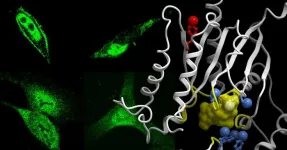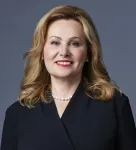(Press-News.org) A group of researchers at University of California San Diego has identified the cause of a “short-circuit” in cellular pathways, a discovery that sheds new light on the genesis of a number of human diseases.
The recent study, published in the journal Science Signaling, explores the biochemical mechanism that can interrupt the cellular communication chain — a disruptive interaction that Pradipta Ghosh, M.D., likens to a game-ending “buzzer.” Ghosh, a professor in the Departments of Medicine and Cellular and Molecular Medicine at University of California San Diego School of Medicine, and Irina Kufareva, Ph.D., an associate professor in the Skaggs School of Pharmacy and Pharmaceutical Sciences at University of California San Diego, are the corresponding authors on the paper.
The paper explains the mechanism of “cross talk” between two cellular pathways, one initiated by proteins known as growth factors and by their cellular receptors. The second pathway is mediated by a completely different G protein-coupled set of cellular receptors (GPCRs). Both classes of receptors deliver molecular messages from outside to inside the cell and signal cells to change in some way. Kufareva says that members of the GPCR family are targets of around 34 percent of all the drugs approved by the U.S. Food and Drug Administration.
“GPCRs are important drug targets mainly due to their involvement in signaling pathways related to many diseases,” she explained, citing mental and endocrinological disorders, viral infections, cardiovascular and inflammatory conditions, and even cancer.
Growth factors enable a second, equally important communication pathway inside the cell that makes the cells grow and divide. Whereas GPCRs act through intracellular molecular switches (G proteins), growth factor receptors are conventionally thought to bypass the switches. However, Ghosh and Kufareva note that researchers had been suspicious about some kind of a potential conflict between the two pathways, and careful research allowed the UC San Diego team to identify it.
Ghosh said the conflict stems from problematic phosphorylation, the attachment of a phosphate group to the G protein molecule. She explained that the team used advanced mass spectrometry techniques to map all occurrences of phosphoevents, the sites on G proteins that were phosphorylated when cells were stimulated by growth factors. Then they checked how this changed the ability of G proteins to perform their normal job downstream of GPCRs.
“Whatever aspect of GPCR signaling we looked at, it was negatively impacted by almost all phosphoevents on the ‘switch’ protein — the G protein — that would be introduced by growth factors,” Kufareva said. “That was understandable when we looked at how these phosphoevents distorted the G protein structure. Growth factors effectively ‘steal’ G proteins from GPCRs and in this way paralyze their signaling."
Further testing of the phosphoevents showed that one single amino acid was responsible for the G protein theft. Ghosh said the amino acid known as tyrosine is located at position 320 within the G protein, which happens to be on the side of the G protein that makes contact with G protein-coupled receptors.
“This specific tyrosine was identified almost a decade ago as a special ‘trigger point’ for G protein-coupled receptors to relay their signals. We began to think about the importance of such a coincidence,” Ghosh explained. “That's when a light bulb went off in our heads: If cell communication were a game, the tyrosine at position 320 on the G protein would be the buzzer. If the growth factors got to it first and phosphorylated that site, the G protein-coupled receptors simply had no shot!”
Kufareva and Ghosh say that the group’s discovery has implications for the development of new therapies for a number of conditions, including cancer. Ghosh said that many pharmaceuticals on the market are effective in treating a wide range of diseases because the drugs target G protein-coupled receptors. But there remain a number of conditions without good drug therapies — fibrosis, chronic inflammation and cancers — because until now the interaction of these two pathways has not been understood.
“We believe our findings are likely to be both important and timely, and will contribute to other emerging studies mapping the landscape of these two major signaling pathways that control practically every process in our cells,” Ghosh said.
“Our work is especially relevant in that growth factors, their receptors, and G-protein-coupled receptors appear to be highly co-expressed in many cancers,” added Kufareva.
All authors on the paper are associated with UC San Diego. Suchismita Roy, Saptarshi Sinha and Ananta James Silas are members of the School of Medicine’s Department of Cellular and Molecular Medicine, while Majid Ghassemian is a member of the Department of Chemistry and Biochemistry, Biomolecular and Proteomics Mass Spectrometry Facility.
This paper was supported by the National Institutes of Health (CA238042, AI141630, CA100768 and CA160911 to Pradipta Ghosh; R21 AI149369, R01 GM136202, R21 AI156662, and R01 AI161880 to Irina Kufareva). Saptarshi Sinha was supported through the American Association of Immunologists Intersect Fellowship Program for Computational Scientist and Immunobiologists.
# # #
END
Chasing down a cellular ‘short circuit’
Team of researchers at UC San Diego identifies cause of cellular miscommunication implicated in the origin of many human diseases
2024-06-04
ELSE PRESS RELEASES FROM THIS DATE:
When mothers and children talk about problems, environment matters
2024-06-04
URBANA, Ill. – Talking to their parents about daily stressors can help adolescents deal with their problems. This is particularly important during the transition to middle school, when youth often are faced with new peer and academic challenges. But does it matter where these conversations take place? That’s the topic of a new study from the University of Illinois Urbana-Champaign.
“We were interested in the environmental settings for mother-youth conversations. Where do they typically happen, and what are the preferred locations? We wanted to get the perspectives of both the youth and their ...
How tumor stiffness alters immune cell behavior to escape destruction
2024-06-04
Immunotherapy is based on harnessing a person’s own immune system to attack cancer cells. However, patients with certain tumors do not respond to these therapies and it remains unclear why.
“The full impact of anti-cancer immunotherapy has not been realized, especially for some solid tumors,” says Kevin Tharp, Ph.D., assistant professor in the Cancer Metabolism and Microenvironment Program at Sanford Burnham Prebys.
Researchers presume that part of the reason why these therapies fail is due to tumor-associated fibrosis, the creation of a thick layer of fibrous collagen (like scar tissue) that acts as a barrier ...
Convergence and collaboration to achieve circularity
2024-06-04
The linear consumption model of raw material extraction, production, use, and disposal dominates the global economy, but it’s led to serious unintended global consequences: from resource use to pollution including negative impacts on environmental and human health that disproportionately affect the Global South.
In contrast, circular economy – a model where products and materials are by design kept in continual use – aims to decouple economic growth from resource consumption.
While approaches ...
Wayne State University partners with Great Lakes Water Authority to help train water pipeline managers of the future
2024-06-04
DETROIT — The Great Lakes Water Authority (GLWA) has partnered with Wayne State University to develop its Workforce Development and Pipe Management Program, which will help recruit, teach and graduate the next generation of water pipeline managers. The two-year program will begin July 1, 2024, and will be supported by a contract totaling more than $480,000.
The GLWA says that water utilities are experiencing significant employee recruitment, training and retention challenges. An additional concern is the availability of specialized technical training that addresses recent technological advances in the water sector. In response to these challenges, the Workforce Development and ...
NRG Oncology abstract considered “best of ASCO” for 2024 shows difference in outcomes for node-negative versus node-positive pancreatic cancer patients when adding chemoradiation to systemic therapy
2024-06-04
NRG Oncology recently reported the results from the radiotherapy randomization, which was the second step of their NRG-RTOG 0848 clinical study comparing adjuvant chemotherapy with or without chemoradiation for patients with resected periampullary pancreatic adenocarcinoma. The trial data did not show that the addition of radiation and chemotherapy to adjuvant systemic therapy improved overall survival (OS) for all patients on the study, however, OS was improved among node-negative patients. OS was essentially the same between treatment arms for node positive patients. The trial data also showed that disease-free survival (DFS) was improved with ...
Emma Guttman-Yassky, MD, Ph.D., receives high honor at European Academy of Allergy and Clinical Immunology
2024-06-04
Emma Guttman-Yassky, MD, PhD, Receives High Honor at European Academy of Allergy and Clinical Immunology
The Paul Ehrlich Award for Experimental Research recognizes scientists who have revolutionized the understanding of allergic diseases and immunological mechanisms.
New York, NY (June 4, 2024) – The 2024 European Academy of Allergy and Clinical Immunology (EAACI) Annual Congress selected Emma Guttman-Yassky, MD, PhD, Waldman Chair of the Kimberly and Eric J. Waldman Department of Dermatology, and Professor of Dermatology and Immunology, Icahn School of Medicine at Mount Sinai, as the recipient of the ...
An anti-inflammatory curbs spread of fungi causing serious blood infections
2024-06-04
A team of UC Davis Health researchers discovered that a common anti-inflammatory drug, mesalamine, can replace the work of good bacteria in fighting the nasty fungus Candida albicans in the gut.
C. albicans, or candida, is known to cause yeast infections. In some cases, it develops into invasive candidiasis, a potentially fatal infection occurring mostly in patients with compromised immunity.
The researchers found that this fungus can’t grow without an oxygen supply. Their study in mice showed that the drug can ...
Intracerebral hemorrhage stroke outcomes improve with early minimally invasive surgery evaluated in clinical trial
2024-06-04
INDIANAPOLIS – Patients with an intracerebral hemorrhage have better medical outcomes when surgeons perform an early minimally invasive removal of a hematoma compared to those receiving the standard of care, according to a study published in the New England Journal of Medicine.
Indiana University School of Medicine faculty clinicians Mitesh Shah, MD, Bradley Bohnstedt, MD, Regg Singh, MD and Jason Allen, MD, PhD are co-authors ...
UC San Diego Health first in region to provide novel therapy for melanoma
2024-06-04
UC San Diego Health is the first hospital system in the region to offer a new immunotherapy treatment for metastatic melanoma. The personalized cellular therapy derived from tumor infiltrating lymphocytes (TIL), is the first solid tumor therapy on the market approved by the U.S. Food and Drug Administration (FDA).
“This one-time cellular immunotherapy is a powerful and robust tool to treat patients with advanced melanoma resistant to other approved therapies and who have limited treatment options,” said Gregory Daniels, MD, PhD, professor of ...
Zapping the right brain cells: The path to improved stimulation
2024-06-04
By Jake Siegel
SEATTLE, WASH.—June 4, 2024—New research by scientists at the Allen Institute’s Brain and Consciousness group and Cedars-Sinai offers an unprecedented look at how neurons respond to ES. Far from being uniform, different types of neurons showed distinct patterns of ‘syncing up’ with electrical fields. These patterns varied depending on the rate at which the ES was delivered.
The findings, published today in Neuron, could help doctors fine tune where, when, and how ...
LAST 30 PRESS RELEASES:
When is it time to jump? The boiling frog problem of AI use in physics education
Twitter data reveals partisan divide in understanding why pollen season's getting worse
AI is quick but risky for updating old software
Revolutionizing biosecurity: new multi-omics framework to transform invasive species management
From ancient herb to modern medicine: new review unveils the multi-targeted healing potential of Borago officinalis
Building a global scientific community: Biological Diversity Journal announces dual recruitment of Editorial Board and Youth Editorial Board members
Microbes that break down antibiotics help protect ecosystems under drug pollution
Smart biochar that remembers pollutants offers a new way to clean water and recycle biomass
Rice genes matter more than domestication in shaping plant microbiomes
Ticking time bomb: Some farmers report as many as 70 tick encounters over a 6-month period
Turning garden and crop waste into plastics
Scientists discover ‘platypus galaxies’ in the early universe
Seeing thyroid cancer in a new light: when AI meets label-free imaging in the operating room
Neutrophil-to-lymphocyte ratio may aid risk stratification in depressive disorder
2026 Seismological Society of America Annual Meeting
AI-powered ECG analysis offers promising path for early detection of chronic obstructive pulmonary disease, says Mount Sinai researchers
GIMM uncovers flaws in lab-grown heart cells and paves the way for improved treatments
Cracking the evolutionary code of sleep
Medications could help the aging brain cope with surgery, memory impairment
Back pain linked to worse sleep years later in men over 65, according to study
CDC urges ‘shared decision-making’ on some childhood vaccines; many unclear about what that means
New research finds that an ‘equal treatment’ approach to economic opportunity advertising can backfire
Researchers create shape-shifting, self-navigating microparticles
Science army mobilizes to map US soil microbiome
Researchers develop new tools to turn grain crops into biosensors
Do supervised consumption sites bring increased crime? Study suggests that’s a myth
New mass spec innovation could transform research
Maternal nativity, race, and ethnicity and infant mortality in the US
Migration-related trauma among asylum seekers exposed to the migrant protection protocols
Jupiter’s moon Europa has a seafloor that may be quiet and lifeless
[Press-News.org] Chasing down a cellular ‘short circuit’Team of researchers at UC San Diego identifies cause of cellular miscommunication implicated in the origin of many human diseases




